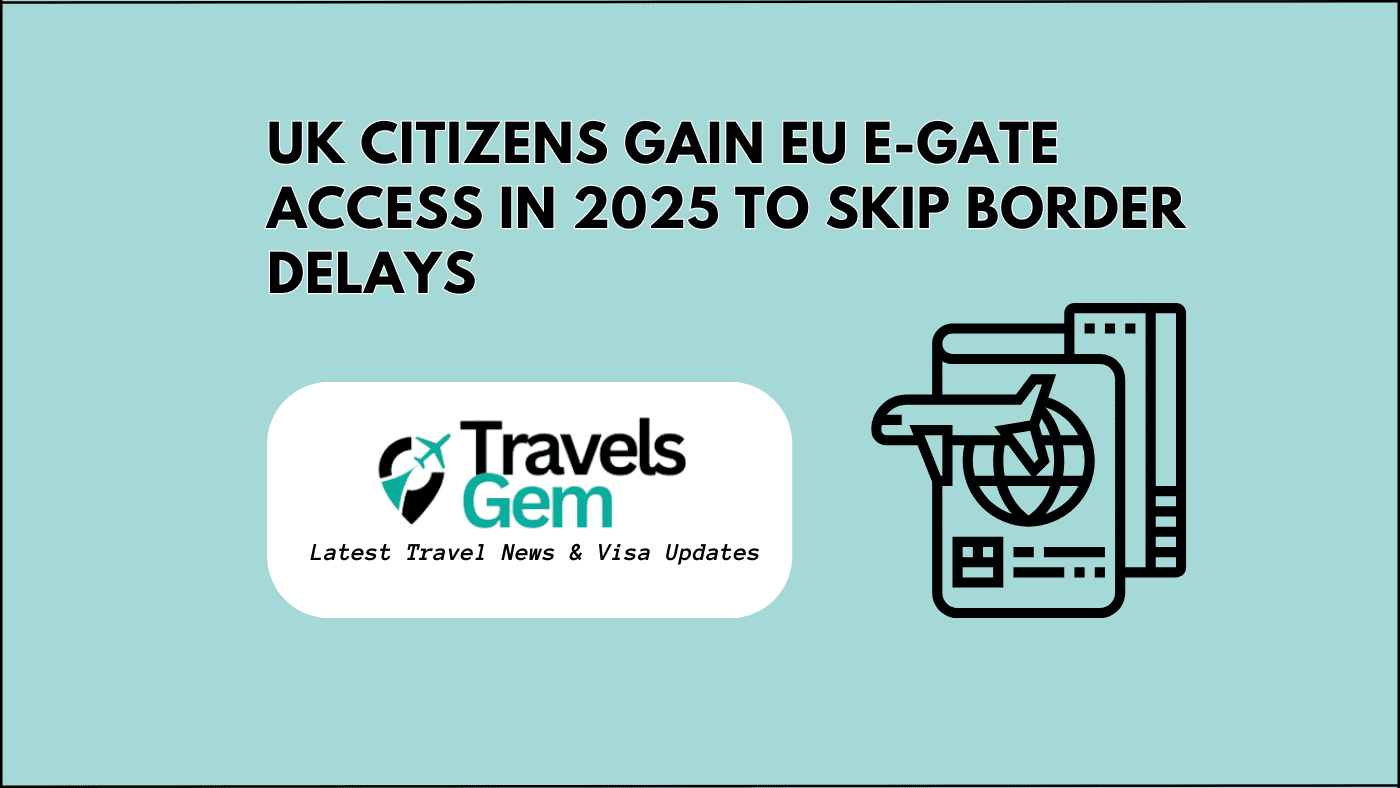The EU will allow UK citizens to use e-gates at many airports and border points starting in 2025, ending long waits caused by post-Brexit manual passport checks. This UK EU e-gate access 2025 agreement, finalized after a UK-EU summit in May 2025, aims to streamline travel for UK tourists and business visitors to EU destinations like Spain, France, or Italy. Conflicting reports suggest the rollout may start in October 2025 with the EU’s Entry/Exit System (EES) or be delayed to 2026 due to technical issues. This article covers the new policy, who qualifies, how e-gates work, and tips for Pakistani travelers transiting the EU, based on data up to May 21, 2025, at 01:19 AM PKT.
What Is the New E-Gate Access Policy?
Post-Brexit, UK citizens lost automatic e-gate access in the EU, requiring manual passport stamping to track the 90-day stay limit within 180 days in the Schengen Area. This led to delays, with queues at airports like Amsterdam Schiphol or Paris Charles de Gaulle reaching 2 hours. The UK EU e-gate access 2025 deal allows UK passport holders to use automated e-gates at many EU airports and borders, reducing wait times to minutes. Key details:
- Timeline: The UK claims access begins in 2025, but the EU ties it to the EES, set for October 2025, with possible delays to 2026 due to system readiness.
- E-Gate Process: E-gates use facial recognition or fingerprints to verify passports and stay limits, replacing manual checks.
- Coverage: Includes Schengen Area airports (e.g., Frankfurt, Madrid) and some non-Schengen EU ports (e.g., Cyprus). Adoption is optional, so not all EU countries will comply.
- Mutual Benefit: EU citizens already use UK e-gates, and this deal removes legal barriers for UK citizens in the EU.
X posts, like @Cilvrnum’s claim of “faster EU borders for Brits,” show excitement, but @PrimroseViews notes EES delays, both unverified. The policy supports the EU’s efficient border goals and the UK’s 30 million annual EU visitors.
Who Can Use E-Gates?
The UK EU e-gate access 2025 applies to:
- Nationality: UK passport holders (all ages) with biometric passports (issued since 2006). Non-UK citizens, like Pakistanis, need separate EU agreements.
- Purpose: Tourism, business, or family visits within the Schengen 90-day limit. Work or study visas have different rules.
- Locations: Schengen countries (e.g., Germany, Spain, Italy) and some non-Schengen EU states (e.g., Romania). Specific airports depend on local implementation.
- Passport: Valid for 3 months beyond your EU departure date.
Pakistani travelers transiting EU airports (e.g., Frankfurt to the UK) won’t use e-gates but may experience shorter queues as UK passengers clear faster. Verify rules at ec.europa.eu.
How Do E-Gates Work?
Using e-gates under UK EU e-gate access 2025 is quick:
- Find E-Gates: Locate e-gates at EU airports (e.g., Barcelona El Prat, Rome Fiumicino) or borders like Eurostar terminals.
- Scan Passport: Place your biometric UK passport on the reader.
- Biometric Verification: Look at the camera for facial recognition or scan fingerprints (required with EES from October 2025).
- Get Cleared: The gate opens if your stay is within the 90-day limit and no issues are flagged. If denied, see a border officer.
- No Stamps: EES digitally tracks entries and exits, removing manual stamping.
The process takes 30–60 seconds. Pakistani travelers with Schengen visas use manual lanes, so carry visa documents. X posts praise e-gate speed, but some warn of glitches, unverified.
Key Details Table
| Aspect | Details |
|---|---|
| Start Date | October 2025 (possible delay to 2026) |
| Eligible Passports | UK biometric passports |
| Covered Areas | Schengen airports, some non-Schengen ports |
| Wait Time Reduction | From 2 hours to 1–2 minutes |
| EES Integration | Digital tracking from October 2025 |
What to Do During EU Travel
With UK EU e-gate access 2025, UK travelers can:
- Tour Easily: Visit Paris, Barcelona, or Berlin within the 90-day Schengen limit.
- Conduct Business: Attend meetings in Brussels or Milan with faster border crossings.
- Transit Efficiently: Connect through EU hubs to global destinations with less hassle.
Pakistani travelers transiting EU airports to the UK or elsewhere may benefit from reduced congestion as UK passengers move quickly. X posts from UK travelers, like “No more EU border chaos,” show relief, but Pakistani travelers note unchanged visa checks, unverified.
Tips for Travelers
To maximize UK EU e-gate access 2025, follow these tips:
- Verify Passport: Ensure your UK passport is biometric (chip icon) and valid for 3 months past your EU exit. Pakistani travelers need a valid Schengen visa.
- Check Airports: Confirm e-gate availability at your destination via ec.europa.eu. Major hubs like Paris Orly are likely early adopters.
- Monitor Stay: UK travelers must stay within the 90-day Schengen limit in 180 days. Use the EU’s calculator at ec.europa.eu.
- Plan for Delays: E-gate access may be delayed to October 2025 or 2026 due to EES issues. Carry funds proof and return tickets.
- Get Insurance: Buy travel insurance for medical emergencies, as EU healthcare is costly. Check cdc.gov for health alerts.
- Arrive Early: Allow time for border checks, as some EU airports may not have e-gates at launch.
- Stay Updated: Monitor gov.uk or ec.europa.eu for EES and e-gate rollout news.
- For Pakistanis: Carry Schengen visa, passport, and itinerary, as e-gates are UK-only. Faster UK flows may ease EU airport waits.
Benefits and Challenges
Benefits
- Quick Borders: E-gates reduce UK traveler wait times from hours to minutes.
- Enhanced Travel: 30 million UK EU visitors gain smoother trips.
- Digital Efficiency: EES eliminates stamping errors.
- Pakistani Transit: Shorter UK queues may ease EU airport congestion for all.
Challenges
- Uncertain Timeline: E-gate access may not start until October 2025 or 2026 due to EES delays.
- Partial Adoption: Some EU countries may skip e-gates, as it’s optional.
- Technical Issues: E-gate failures could cause delays, seen in EU trials.
- No Pakistani Access: Pakistani travelers face manual checks, unchanged by the deal.
Why This Policy Matters
The UK EU e-gate access 2025 policy reverses a Brexit hurdle, restoring fast border crossings for UK citizens, delayed since 2020. It aligns with the EU’s EES to modernize border control, benefiting 30 million UK EU visitors and EU tourism economies. For Pakistani travelers, transiting EU hubs like Amsterdam may be faster due to reduced UK passenger delays, though Schengen visa rules remain strict. X posts reflect UK optimism, but some doubt timelines, unverified. The deal strengthens UK-EU travel links without impacting Pakistan’s travel policies.
What’s Next?
The EU’s EES, enabling UK e-gate access, is planned for October 2025 but may slip to 2026 due to technical delays, per the EU Commission. Some EU airports (e.g., France, Spain) already allow limited UK e-gate use, but full rollout awaits EES. The EU Travel Authorisation System (ETIAS), starting May 2025, won’t affect e-gates but adds pre-travel checks for visa-exempt travelers. Pakistani travelers should monitor Schengen visa rules, unaffected by this deal. Check gov.uk or ec.europa.eu for updates.
Conclusion
UK EU e-gate access 2025 allows UK citizens to use e-gates at EU airports, slashing border waits to minutes, starting October 2025 or possibly 2026. The table above lists key details. UK travelers need biometric passports and must follow the 90-day Schengen limit. Pakistani travelers transiting the EU benefit from faster queues but need Schengen visas. Check gov.uk or ec.europa.eu, get insurance, and plan for delays. Enjoy smoother EU travel with this policy.





